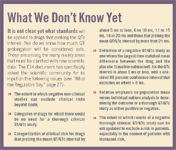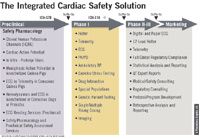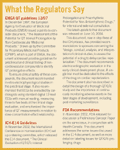QT Prolongation: Closing in on the Target of Meaningful Data
A prolonged QT interval creates an electro-physiological environment that is favorable for the development of cardiac arrhythmias.
A new study in Holland suggests that yet another group of antipsychotic and gastrointestinal treatments have been linked to increased risk of sudden cardiac death. In a longitudinal study by doctors from seven medical centers in the Netherlands, Thorazine (chlorpromazine), Haldol (haloperidol), and Orap (pimozide)—as well as two gastrointestinal drugs, Propulsid (cisapride) and Motilium (domperidone)—have been linked to increased risk of irregular heartbeat.

Like many medications before them, these drugs have been shown to prolong the QT interval, the few hundred milliseconds of electrical activity that control the heart's pumping action. QT prolongation has become a significant concern for pharma and FDA since the early 1990s, when Seldane (terfenadine), a popular antihistamine headed for OTC status, was derailed by data that linked it with sudden cardiac death and life-threatening ventricular tachyarrhythmias, such as Torsades de Pointes (TdP). In the years since, an increasing number of drugs—antihistamines, antipsychotics, antidepressants, and antibacterials—have been given additional warnings or pulled from the market because they increased the QT interval.
QT prolongation is not likely to go away as an issue for the pharmaceutical industry. In 2001, FDA's Janet Woodcock told the Los Angeles Times that the agency had lost patience with drugs that caused it. "We're encouraging people, if there's QT prolongation, don't develop it," she said.
It is increasingly important for pharma researchers to understand what QT prolongation is and how it affects clinical development and drug safety.
What is the QT interval?
The QT interval is part of the cardiac cycle as it is represented on paper with an electrocardiograph (ECG or EKG). The cardiac cycle—a single heartbeat—starts when the atria begin to fill with blood, and ends when the ventricles recover from the contraction that propels blood throughout the body.

Cardiac Cycle
An ECG represents the heartbeat as a series of waves that measure electrical changes in the walls of the heart—depolarization and repolarization—that accompany the blood movement. The QT interval is the time, in milliseconds, between the depolarization (Q) at the onset of ventricular contraction and the repolarization (T) that prepares for another contraction.
What is the normal QT interval?
The normal QT interval varies with the heart rate. That's why the QT interval is corrected for what it would be theoretically, at a rate of 60 beats per minute. This is known as the QTc (corrected QT interval). The normal QTc generally is accepted to be less than 440 ms, and on average is slightly longer in females. FDA concept papers have mentioned normal QTc as:
- <430 ms in males and <450 ms in females
- borderline between 430 and 450 ms for males and between 450 and 470 ms for females.
A prolonged QTc has been defined as > 450 ms in males and > 470 ms in females. A QTc increase to > 500 ms during therapy should arouse concern among investigators. According to the International Conference on Harmonization (ICH) and concept papers, a change from baseline QTc greater than 30 ms must be addressed in the categorical analysis.
Which QT correction formula gives the best data?
Because the QT interval changes with heart rate, correction formulae (traditionally, those applied by Fridericia (QTcF) or Bazett (QTcB)) are used to "correct" QT levels to represent a standardized heart rate of 60 beats per minute. Scientific literature suggests that these formulae show QT variations at different heart rates. Bazett's method, in particular, overcorrects at elevated heart rates and undercorrects at low heart rates. Linear-regression techniques and correction formulae derived from subject data have been suggested by the concept papers for QT correction. Regulatory authorities also propose these data to be submitted in addition to QTcB and QTcF data.
Why is a prolonged QT interval dangerous?
A prolonged QT interval creates an electrophysiological environment that is favorable for the development of cardiac arrhythmias, especially the polymorphic ventricular tachyarrhythmia known as TdP. When a drug—especially a drug that is not designed for heart ailments—prolongs the QT interval, prolongation acts as a surrogate marker for the proarrhythmic potential of the drug. The concern is that some drugs that prolong the QT interval could cause life-threatening arrhythmias.

What We Don't Know Yet
How much QT prolongation are regulators likely to allow?
The FDA concept paper issued in 2002 says drugs that prolong the mean QT/QTc by 5 to 10 ms have not been associated with proarrhythmic risks. However, drugs causing a mean increase of 10 to 20 ms are of concern, and those correlating with increases beyond 20 ms have an increased likelihood of being proarrhythmic. Both the concept papers and the E14 document have invited the scientific community for comments on the choice of 5 ms as the threshold value for safety concerns. (See "What We Don't Yet Know.")
How early in the R&D process can a QT/QTc study be carried out?
To maximize return on investment, QT-interval studies should be moved up as early in the development process as possible. A 2003 paper in Toxicologic Pathology suggests the use of beagle dogs as the most reliable model for preclinical assessment of the QT interval. This will streamline the early drug-development process and enable sponsors to eliminate some drugs before they reach the costly clinical stages. This data also can reduce the need for intensive ECG evaluation in Phase II/III for other compounds. Both of these outcomes will result in substantial cost savings in the later stages of development. Preclinical QT/QTc studies indicating prolongation call for an expanded ECG evaluation in later stages of development. This helps sponsors decide early on whether to continue investment in the molecule. (See "The Integrated Cardiac Safety Solution".)

Beginning cardiac safety studies as early as the preclinical phase enables clinical research teams to make go/no-go decisions earlier in the process and maximize their return on investment.
How reliable is ECG data collection across a group of patients?
The data are reliable as long as collection methods are consistent. Study sponsors must use a small group of readers to evaluate and interpret the ECGs. All the readings should be done under a set of consistent standard operating procedures defined prior to study start.
The ECGs must be recorded using the standard 12-lead ECGs, read manually (hand-held calipers, on-screen digital calipers, digitizing pads), and interpreted by cardiologists. The systems used for ECG evaluation must be calibrated, validated, and documented.

What the Regulators Say
How do regulatory bodies want to receive the data?
The regulatory agencies are clear about the importance of complete, integrated cardiac safety data in any regulatory submission. The sponsor must provide complete, comprehensive, and authentic data in a uniform format. The recommended formats are digital ECG collection, and submission in XML format. This allows the regulatory authorities to view the annotations on the ECGs.
How much can an early study tell us about a drug's cardiac effects on the general population?
A thorough QT/QTc study on healthy volunteers will give researchers a fairly good idea about the cardiac repolarization effects of a drug. More data can be gleaned from the additional ECGs during the development process. However, the most important sources of information about QT effects remain post-marketing data and reported adverse events.
It is very important to assess the need of a thorough QT/QTc study in light of preclinical data on cardiovascular safety. It is ideal to plan a thorough QT/QTc study early in the development phase to strengthen the case for an approval/disapproval from regulatory bodies. It also allows for further planning of cardiac safety evaluation during the later stages of development.
A study on QT prolongation, demonstrated by nine non-cardiac drugs during in-vitro studies in dogs compared with in-vivo studies, revealed that six of the drugs showed a positive finding with in-vitro methods and seven with in-vivo methods. Thus, a well-designed preclinical assessment of QT interval prolongation, in accordance with ICH guidelines, will serve as a good indicator of the need for future cardiac safety investigations.
A robust preclinical evaluation, combined with a thorough QT/QTc study, if negative, may preclude the need for intensive ECG evaluation in Phase II/III—thus resulting in substantial cost saving in the later stages of development. A positive QT/QTc study almost always will call for an expanded ECG evaluation in later stages of development. This also is in the best interest of sponsors. Since they are in a position early on to decide about further investment in the molecule, having the appropriate data may bring more efficiency to their R&D strategy.
How does the risk-benefit analysis vary from drug to drug?
While it is important to do thorough cardiac-safety profiles for all drugs, the benefit of any drug must be weighed against the risk. It is particularly important for new drugs for which a viable, safe alternative already is available in the market. For example, the risk-benefit analysis for a drug that treats schizophrenia would be very different from the risk-benefit analysis for an analgesic or an antihistamine. Obviously, the risk-benefit profile will differ if a viable safe alternative already exists for a new drug.
Given what we know now, is there already an effective strategy for assessing the cardiac safety of drugs?
In general, manufacturers need to be proactive about cardiac-safety analysis for any drug, since this is a prerequisite for approval. By planning a thorough QT study early in development, researchers can achieve proof of concept early in the development life cycle; the investment is well worth the initial expenditure.
Compliance with regulatory authorities in data collection and submission is a cost-cutter; having digital ECGs analyzed by a core group of readers and submitted in XML format is recommended. Finally, top managers must assess the risks of a compound in a holistic risk-benefit framework, keeping in mind the preclinical results, the thorough QT study results, and the class of the compound.
Jogin Desai, MD (jogin.desai@quintiles.com) is executive director and Sheetal Shetty, MD (sheetal.shetty@quintiles.com) is a medical writer, both with Quintiles ECG Services, based in Mumbai, India.

FDA Grants Priority Review to Regeneron’s Eylea for Macular Edema Following Retinal Vein Occlusion
April 18th 2025Regulatory action was based on data from the Phase III QUASAR trial, which demonstrated that Eylea HD dosed every eight weeks achieved non-inferior visual acuity outcomes compared to Eylea in patients with macular edema following retinal vein occlusion.
Navigating Distrust: Pharma in the Age of Social Media
February 18th 2025Ian Baer, Founder and CEO of Sooth, discusses how the growing distrust in social media will impact industry marketing strategies and the relationships between pharmaceutical companies and the patients they aim to serve. He also explains dark social, how to combat misinformation, closing the trust gap, and more.